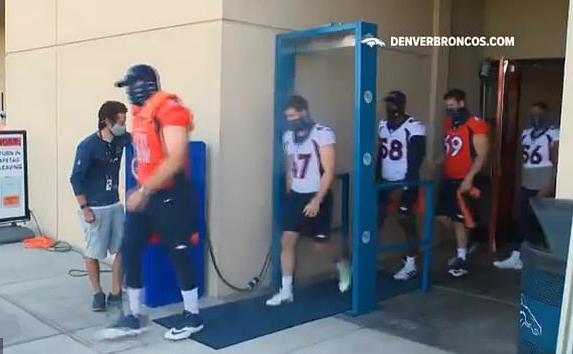
According to the team, it’s a way of disinfecting them to help stop the spread of coronavirus, but even people without a scientific background can spot the flaws with this approach from a mile away.
The main mode of COVID-19 transmission is close contact with others. We know that coughing, sneezing, talking and even breathing in the vicinity of someone can spread virus-containing respiratory droplets in the air that can infect others. The virus is carried in people rather than on them, and the chances of someone getting it just by touching another person’s clothes are not that high if they wash their hands. It's what they’re carrying inside them that we need to worry about – and this booth does nothing to address that.
An infected person could pass through this booth a hundred times a day and still pass the virus on to someone if they cough or sneeze right after they walk through or possibly even talk in their direction. So what’s the point?
In an email to USA TODAY Sports, Yale School of Medicine professor and infectious disease specialist Dr. Choukri Ben Mamoun wrote: "It is clear that if a player is infectious while entering the booth, there is a very good chance that he will still be infectious coming out of the booth and will transmit the virus to other players."
Misting booths could have negative health effects
At best, this may just be a waste of money. However, there are two ways that this could be quite dangerous. The first is the false sense of security it may give players and other people who pass through these booths. If someone believes they are “safe” from the disease after using it, they may not use the same type of caution they would have otherwise exercised when it comes to social distancing and mask wearing – and that could prove to be a fatal mistake.
According to the NFL Players Association, 59 NFL players have tested positive for coronavirus at some point during the pandemic, in addition to staff and other league personnel. Broncos star pass rusher Von Miller suffered from the disease in April. He has since recovered and said that he had been thinking about opting out of the season, but he ultimately decided to play because of safety protocols put in place by the Broncos. They’re going to need more than this booth if they want to make a difference, however.
Another huge concern is that the disinfectant solutions used in the misting booths could be dangerous. According to a spokesperson for the Broncos, the disinfectant is known as microSURE. It is said to be non-toxic and reportedly works by “killing microbes and pathogens instantly by forming millions of nano-crystalline structures.”
The company that makes microSURE does not own the misting booths, but they have defended their spray, saying it can stick to surfaces for longer than typical chemical agents thanks to the mechanical barrier they create. However, their co-founder, Dr. Erwin Lo, was not willing to share what it’s made of with the media, which is very telling.
A fact sheet for one microSURE Hand Sanitizer on the U.S. National Library of Medicine’s DailyMed site lists the active ingredient as being benzalkonium chloride. This is one of the ingredients that the FDA has warned people to avoid. However, through one of those FDA loopholes that is responsible for allowing many dangerous products on the market, sanitizers with this ingredient can be legally marketed as long as they meet certain marketing requirements.
The World Health Organization has warned that spraying disinfectants across a broad space indoors or outside in hopes of killing coronavirus could harm more than it helps. Spraying it on people is particularly dangerous, they said, given the risks to the people's eyes, the potential for skin and respiratory irritation, and other health effects.
It’s not clear if players are actually required to pass through the booth if they want to keep their job, but it wouldn’t be surprising. No one knows for sure what it is that is being sprayed, and it’s scary to think that something like this could be implemented on a wide scale using other types of chemicals for more nefarious purposes on the pretense of “preventing” the virus. From there, it’s not much of a stretch to imagine the masses blindly lining up for risky vaccines in the name of safety.
Sources for this article include:
Please contact us for more information.






















